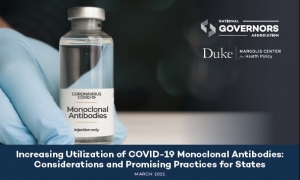
Policy Brief
Increasing Utilization of COVID-19 Monoclonal Antibodies: Considerations and Promising Practices for States
Published date
Since November 2020, the U.S. Food and Drug Administration (FDA) has issued emergency use authorizations (EUAs) for three COVID-19 monoclonal antibodies (antibody treatments) to treat those age 12 and older with mild to moderate COVID-19 at high-risk for progressing to severe illness. The treatments are laboratory-made proteins that mimic the immune system’s ability to fight off harmful viruses and data suggest these antibody treatments reduce hospitalization rates or emergency room visits and may reduce viral load as well as alleviate symptoms.
Although demand for COVID-19 antibody treatments was expected to far outstrip initial supply, roughly 75 percent of treatment courses allocated to states remain available. There are several factors that have contributed to this unexpected mismatch between supply and use. First, states receive allocations of COVID-19 antibody treatments from the federal government and generally distribute them to hospitals and health systems who request it. However, many hospitals and health systems have been slow or unable to set up outpatient infusion sites for treatment. Operational challenges, including lengthy testing turnarounds when patients require fast referrals, limited workforce capacity, as well as limited awareness of and confidence in these treatments among patients and providers have all contributed to low utilization across the states.
Second, data on the three authorized COVID-19 antibody treatments are limited, primarily based on information from Phase II trials with small numbers of patients. As a result, states, providers, and academic experts have called for additional evidence to inform use across a variety of domains and several randomized trials are underway. However, previous data and new findings from ongoing clinical trials underscore the key role of COVID-19 antibody treatments to reduce hospitalization and death from COVID-19.
In light of these challenges, this paper presents ways Governors can increase utilization of COVID-19 antibody treatments and highlights select promising state practices. Promising practices include: establishing regional infusion sites, partnering with medical professional associations, co-locating infusions at testing sites, generating real-world evidence by tracking patients for side effects and hospitalizations, strategic communications, and other approaches to increase provider readiness and promote greater uptake. Although COVID-19 cases are declining, the increasing prevalence of new variants — as many individuals remain unvaccinated — underscores the need to promote and adopt strategies that increase utilization of COVID-19 antibody treatments. Until many more individuals are vaccinated, these treatments will be critical for those who continue to be susceptible to severe COVID-19 disease.
